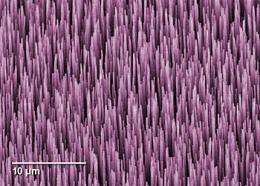Prototype device measures absolute optical power in fiber at nanowatt levels

(PhysOrg.com) -- Researchers at the National Institute of Standards and Technology (NIST) have demonstrated a prototype device capable of absolute measurements of optical power delivered through an optical fiber.
The device is the world's first fiber-coupled cryogenic radiometer that links optical fiber power measurements directly to fundamental electrical units and national standards. It uses a microscopic forest of carbon nanotubes—the world's darkest material—to measure values that are about one-thousandth of the levels typically attained with a cryogenic radiometer lacking direct fiber input capability. With improvements in temperature control and speed, the device could meet the needs for ultraprecise calibrations at ultralow power in telecommunications, medical devices and other industries.
Optical power and energy are traceable to fundamental electrical units. Radiometers absorb optical energy and convert it to heat. Then the electrical power needed to induce the same temperature increase is measured. Because optical and electrical heating are not exactly equivalent, measurement uncertainties can be relatively large from a metrology point of view.
The demonstration is also a step toward converting radiometry from a classical practice based on electrical units to a quantum practice based on single particles of light (photons).
"We have many customers who request optical power measurements in fiber, mainly for optical communications," project leader John Lehman says. "Also, our single-photon measurements are done in fiber."
The new radiometer is about 70 millimeters (mm) long and incorporates a 1.45-mm-thick optical fiber capped by a light-trapping cavity at one end with the nanotube absorber and a heater. The ultra-dark nanotubes are grown on a tiny X-shaped piece of micromachined silicon. Light absorption was so high it was difficult to determine measurement uncertainties; Lehman travelled to a special facility at the National Physical Laboratory (the British equivalent of NIST) to make some measurements.
Experiments and calculations indicate the new radiometer can measure a power level of 10 nanowatts with an uncertainty of 0.1 percent. By comparison, typical measurements of optical power delivered through fiber have an uncertainty of 3 percent or more at similar power levels. More importantly, these commercial devices rely on a series of calibrations to establish traceability to national standards.
NIST aims to develop an absolute quantum standard for optical power and energy based on single photons. The effort includes development of sources and detectors spanning a wide range of optical power measurements, from single photon counts to trillions of photons. Single photons are already used in quantum communications systems, which offer novel capabilities such as detecting extremely weak optical signals and providing quantum guarantees on security.
More information: D. Livigni, N. Tomlin, C.L. Cromer and J.H. Lehman. Fiber-coupled cryogenic radiometer with carbon nanotube absorber. Paper presented at 11th International Conference on New Developments and Applications in Optical Radiometry (NEWRAD 2011), Maui, Hawaii, Sept. 19-23, 2011.
D.J. Livigni, N.A. Tomlin, C.L. Cromer and J.H. Lehman. Optical fiber-coupled cryogenic radiometer with carbon nanotube absorber. Metrologia. Forthcoming.
Journal information: Metrologia
Provided by National Institute of Standards and Technology



















